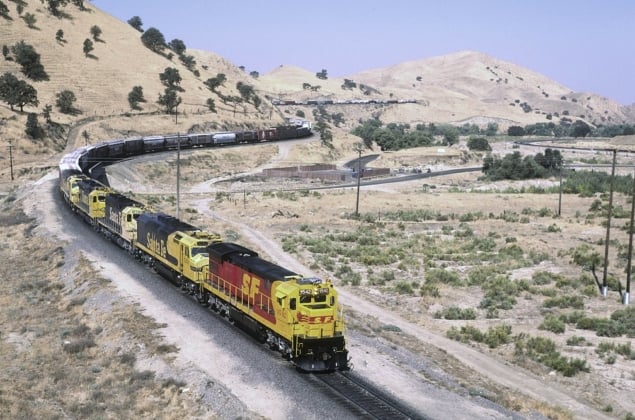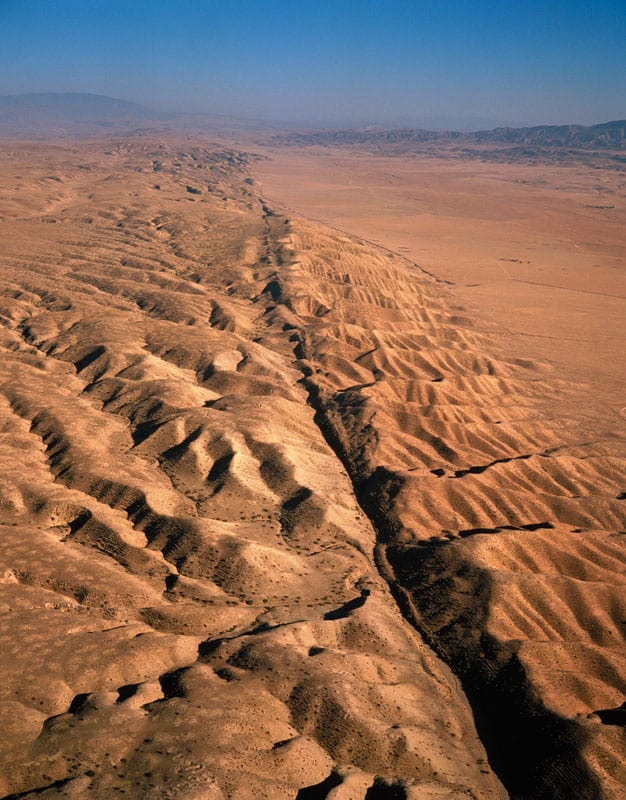
Early signs of hazardous earthquake activity across Southern California can be detected using the passage of freight trains, which produce surprisingly strong seismic signals. That is the claim of researchers in France, Belgium and the US, who have demonstrated the detection principle on the dangerous San Jacinto Fault. The team has also calculated that the same approach could be used to monitor almost the entirely of California’s San Andreas Fault.
Reliable earthquake prediction is the holy grail of seismological research. Laboratory experiments have revealed that earthquake activity should be preceded by local changes in seismic velocity around the fault zone. In theory, it should be possible to monitor real-world faults for these signals of an impending rupture. In practice, however, the operation of continuous, high-energy seismic sources required for the ongoing probing of the Earth’s crust is prohibitively expensive.
“Predicting the occurrence of damaging earthquakes is still a great challenge,” says Florent Brenguier, a seismologist at the Université Grenoble Alpes. “This is because we lack direct observations of the processes leading to fault rupture at depth.”
Stronger than expected
Now, Brenguier and colleagues may have found a way to repeatedly and economically probe the crust by using railway traffic an existing seismic source. Freight trains have already been recognized as a source of seismic noise, which is generated as the heavy trains push down on the ground over which they run. It had been thought that their seismic signals would only be strong enough to probe the shallow surface, until a study last year by Asaf Inbal and colleagues reported the detection of clear seismic signals from freight trains tens of kilometres from the railway line itself. This suggests that the trains radiate a relatively high level of seismic energy.
In their new study, Brenguier and colleagues calculated that the seismic noise generated by the passage of freight train traffic running across Southern California each day is equivalent to a magnitude 2.2 earthquake. This is enough to penetrate the crust to a few kilometres depth—and should be detectable tens of kilometres from the railway.
For a proof-of-principle, the researchers studied the San Jacinto strike-slip fault, which runs through the Southern Californian counties of San Bernardino, Riverside, San Diego and Imperial. Based on historic earthquake activity, the San Jacinto fault is believed to pose a significant seismic risk in the region.
Millions at risk
“A large earthquake on the San Jacinto fault could cause major damage in several highly populated Southern California counties — with around five million inhabitants — located at distances of 15-150 km from the fault,” Brenguier explains. He adds, “The trifurcation zone of the San Jacinto Fault is one of the most seismically active areas in Southern California producing more than 10% of all earthquakes in this region”.
By placing sensors on either side of the railway line in the Coachella Valley—at the Piñon Flat Observatory and the Cahuilla Indian Reservation—the researchers were able to correlate recordings of the seismic noise from moving trains. They were able to reconstruct these data as virtual, high-frequency pressure-wave (P-wave) signals crossing the San Jacinto Fault line down to a depth of 4 km. This covers the upper seismogenic zone, where many earthquakes originate.
To confirm that trains were indeed the source of the noise used to probe the fault, the researchers analysed the seismic data recorded at the Piñon Flat array, finding 25 daily tremor-like signals, each lasting around 15 min. These correlated with the times that trains pass through the Coachella Valley.
Covering most of the San Andreas Fault
Brenguier and colleagues also explored the potential to use their approach more broadly, to monitor for earthquake activity across California. Modelling the railway network and distinguishing between hard-rock sites and sedimentary basins, the team found that their seismic interferometry method has the potential to be applied to almost the entirety of the San Andreas Fault system.

How to forecast an earthquake
“This work is the first comprehensive report to utilize seismic signals from car/truck/train traffic for continuous monitoring Earth’s structure,” says Taka’aki Taira, a geophysicist at the University of California, Berkeley, who was not involved in the study.
He adds, “They demonstrate that we can turn traffic noise into persisting and predictable seismic sources, which opens up new exciting opportunities in Earth science.”
With their initial study complete, the researchers are now beginning a large-scale and longer-term seismic monitoring experiment in Southern California using the same principles, with the overall aim of improving their ability to forecast damaging earthquakes.
The research is described in the journal Geophysical Research Letters.



